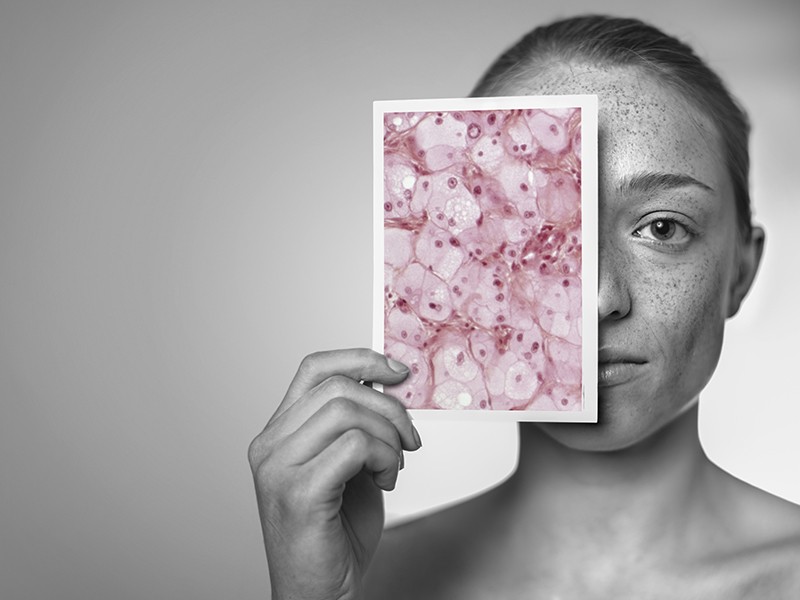Survey finds that ‘normal’ human tissues are riddled with mutations.
Skin has a high level of mosaicism compared to other tissues in the body.Credit: Science Photo Library
The human body is a complex mosaic made up of clusters of cells with different genomes — and many of these clusters bear mutations that could contribute to cancer, according to a sweeping survey of 29 different types of tissue.
It is the largest such study to date, and compiles data from thousands of samples collected from about 500 people. The results, published on 6 June in Science1, could help scientists to better understand how cancer starts, and how to detect it earlier.
“We now appreciate that we are mosaics’, and that a substantial number of cells in our body already carry cancer mutations,” says Iñigo Martincorena, a geneticist at the Wellcome Sanger Institute in Hinxton, UK. “These are the seeds of cancer.”
Tissue mosaics arise as cells accumulate mutations — from DNA errors that creep in during cell division, or because of exposure to environmental factors such as ultraviolet light or cigarette smoke. When a skin cell with a given mutation divides, it can create a patch of skin that is genetically different from its neighbours.
Previous studies have found high levels of mosaicism in the skin2, oesophagus3 and blood4. Those results were typically gleaned from sequencing specific genes in microscopic tissue samples.
Complex patterns
These studies caught the eye of Gad Getz, a computational biologist at Massachusetts General Hospital in Boston. Getz and his team decided to take a different tack: rather than sequencing DNA from minute samples, they would mine a database of RNA-sequence data from the Genotype-Tissue Expression (GTEx) project. Because the body uses DNA as a template for making RNA sequences, mutations in DNA are sometimes reflected in RNA.
The decision to study RNA gave Getz and his colleagues quick access to data from 6,700 samples taken from 29 tissues in about 500 people. But their approach has its drawbacks. Not all DNA codes for RNA, so not every DNA mutation will be evident in RNA sequences. And because the samples used for the GTEx project are relatively large, the DNA signature from small clusters of cells with unique genomes might be be drowned out by the far larger numbers of other cells.
Overall, the study found fewer examples of mosaicism in some types of tissue than would be expected on the basis of previous research. But the key, says Martincorena, is that the latest analysis demonstrated that mosaicism is present across a wide array of tissues.
Tissues with a high rate of cell division, such as those that make up the skin and oesophagus, tended to have more mosaicism than tissues with lower rates of cell division. Mosaicism also increased with age, and was particularly prevalent in the lungs and skin — tissues that are exposed to environmental factors that can damage DNA.
Subtle signals
A gene called TP53 — which helps to repair DNA damage and is known as the ‘guardian of the genome’ — was one of the most common mutation sites. Certain changes in TP53 are associated with cancer, but it might take additional mutations in other genes before cells give rise to tumours.
“What we’re seeing are some of the earliest precancerous changes that are then going to accumulate more mutations,” says Erin Pleasance, who studies cancer genomics at the British Columbia Cancer Agency in Vancouver, Canada. “Eventually a small proportion of these may become cancer.”
Researchers now need to find ways to sort out which of those cells will become tumours and which are ‘normal’, says Cristian Tomasetti, an applied mathematician at Johns Hopkins Medicine in Baltimore, Maryland. That could be crucial for improving efforts to detect cancers early.
Tomasetti has developed methods for detecting tumour DNA circulating in the blood, which researchers hope could one day be used to find early signs of cancer. But he says that his team was initially surprised to find that some of the mutations in their results — which are associated with cancer, and so could have indicated the presence of a tumour — were from a group of normal blood cells.
“This messy situation is the new normal,” Tomasetti says. “The challenge is now to figure out up to what point we call something normal.”
(원문: 여기를 클릭하세요~)
Somatic mosaicism in normal tissues
Somatic cells can accumulate mutations over the course of an individual’s lifetime. This generates cells that differ genetically at specific loci within the genome. To explore how this genetic diversity in individuals contributes to disease, Yizhak et al. developed a method to detect mutations from RNA sequencing data (see the Perspective by Tomasetti). Applying this method to Cancer Genome Atlas samples and normal samples from the Genotype-Tissue Expression (GTEx) project generated a tissue-specific study of mutation accumulation. Somatic mutations were detected in nearly all individuals and across many normal human tissues in genomic regions called cancer hotspots and in genes that play a role in cancer. Interestingly, the skin, lung, and esophagus exhibited the most mutations, suggesting that the environment generates many human mutations.
Science, this issue p. eaaw0726; see also p. 938
(원문: 여기를 클릭하세요~)
